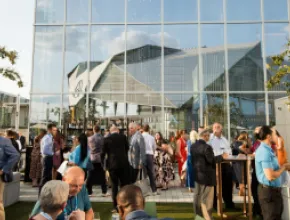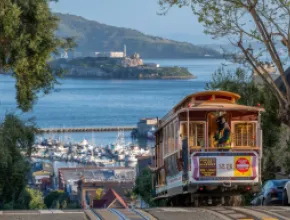Historical venues and attractions can lend interest, class and mystique to an event. When a vintage property receives regular investments and loving attention, it can even improve with age. The historical venues of Monterey, Santa Cruz and Carmel just keep getting better, and groups are certain to find something new at these old favorites.
MONTEREY
In 2002, Monterey observed its quadricentennial, marking 400 years since the first European stepped ashore on its beach. Between 1777 and 1846, the city served as the capital of Alta California during Spanish and Mexican rule. In the past year, several historical treasures have undergone improvement projects.
“Monterey has a deep and rich history that greatly enhances and dimensionalizes the meeting experience for attendees,” says Linda Ruby, vice president of sales and group services at the Monterey County CVB. “From our beginning as California’s first capital city to the stories from John Steinbeck and so much more, the region’s history provides an added layer of meaningful authenticity to the experience.”
After years of closure due to budget cuts, the 19th century adobe buildings of Monterey State Historic Park reopened in January. Private guided tours are available for groups of 14 or more. The park’s many sites of interest include the location where explorers first landed in Monterey in 1602, one of the country’s only remaining whalebone sidewalks and the oldest government building in California.
Located in Old Town Monterey near the state historic park, Casa Munras Hotel & Spa was the first hotel in Monterey. Built in 1824, the property retains its original adobe walls around what is now the 75-person Marabella meeting room. Casa Munras will begin an improvement project to refresh its 170 guest rooms this spring. The property can host groups as large as 200.
Dowtown Monterey boasts numerous historical attractions, including Cannery Row. Centrally located amid the rich historical setting is the Monterey Meeting Connection, encompassing the Monterey Conference Center, Portola Hotel and Spa and the Monterey Marriott, offering a combined total of 61,000 square feet of meeting space.
Asilomar State Beach and Conference Grounds in Pacific Grove marked its 100th anniversary in 2013 with a $20.5 million renovation. Completed in August, the project overhauled the 372-seat Crocker Dining Hall, refurbished Hearst Social Hall and added free Wi-Fi, ping-pong tables and fire pits, and installed 30 additional restrooms throughout the 107-acre park. The property has 30,000 square feet of meeting space, and its conference facility was designed by noted architect Julia Morgan to serve as a retreat for the Young Women’s Christian Association.
Meanwhile, Point Pinos Lighthouse, which has swept the Pacific with its focused beam since 1854, is currently undergoing a restoration project. A team of volunteers has been working to repair the exterior and interior of the Pacific Grove landmark, which is listed on the National Register of Historic Places, and to restore it to its state during the 1930s. Groups are welcome to take self-guided tours of the lighthouse, which is located on the back nine of Pacific Grove Golf Links.PageBreak
SANTA CRUZ
For 100 years, the Santa Cruz Wharf has jutted a half-mile out into Monterey Bay. Originally built to dock deep-water ships and store their freight, it is currently a major tourist destination. The wharf celebrates its birthday in 2014, attended by a flurry of excitement and plans for improvement.
“Aside from attending the centennial celebration and fireworks spectacular planned for October 2014, groups can celebrate the wharf by taking a free eco tour on Saturdays year-round,” says Krista Rupp, sales and marketing manager for the Santa Cruz County Conference and Visitors Council. “The docent-led tour will educate attendees about the ongoing environmental stewardship and marine research of the Greenwharf Project.”
In addition to continuing efforts to improve the environmental profile of the wharf, there is a major study under way to identify needed repairs and renovations and to connect the wharf with other local attractions.
Olitas Cantina & Grille offers fresh Mexican food on the wharf and can host banquets as large as 150.
The Santa Cruz Beach Boardwalk has delighted generations of families and has been hosting group events since 1911. This year, its signature ride, the Giant Dipper roller coaster, celebrates its 90th birthday. The coaster is one of the oldest in the country, and has been designated a National Historic Landmark along with the Boardwalk’s carousel. PageBreak
Events at the Boardwalk are always a hit with groups.
“It’s the nostalgia and the memories, being connected to a simpler time,” says Kathie Keeley, director of sales at the Boardwalk. “Even people who have never been here before, it reminds them of their childhoods. We’re such an authentic and unique experience. There’s so much love that goes into this place, and I think people really feel that.”
There’s something new almost every year at the Boardwalk, and this year is the grand opening of a new spinning roller coaster, the Undertow. The Boardwalk can host groups as large as 5,000 for outdoor picnics on or near the beach. There is 20,000 square feet of indoor banquet space at Cocoanut Grove.
Constructed in 1964 and expanded in 1973, Santa Cruz Harbor turns 50 this year. It is a popular destination for locals and landlubbers alike, featuring restaurants, bay cruise departures and a free water taxi to get visitors around the harbor.
Groups as large as 35 can depart from the harbor aboard the Chardonnay II, a 70-foot luxury yacht. Cruises include a sunset sail, a champagne brunch, a beer cruise and a team-building voyage wherein groups learn to sail the vessel.
Since 1969, the Crow’s Nest has drawn locals and tourists alike to the harbor. Located right on the beach and offering panoramic views of the harbor, lighthouse and wharf, the restaurant can host 55 guests in its private Harbor Room, 24 on the deck, and groups larger than 50 for outdoor events on the beach.
Built in the 1920s, Chaminade Resort & Spa served as a monastic retreat and a religious high school before opening as a hospitality property in 1985. The Spanish Mission-style resort is slated to undergo a complete renovation of all guest rooms in 2015. There are 12 meeting rooms at the IACC-approved property.
Legendary female athlete Marion Hollins began building Pasatiempo Golf Club in 1928. She intended to construct the best golf course west of the Mississippi River, and Pasatiempo is still highly ranked in the nation. Hollins House, the club’s elegant restaurant, recently upgraded its heating system and beautiful parquet floors. Hollins House can accommodate meeting groups as large as 25, and the clubhouse next door can welcome an additional 25.
CARMEL-BY-THE-SEA
Founded as an artist colony in the early 1900s, Carmel has recently seen several of its most historic properties renovated. In 2012 three properties completed significant improvement projects: the boutique Cypress Inn, with meeting space for 14; La Playa Hotel, which can host 200; and Sunset Cultural Center, with 700 seats.
Meanwhile, Quail Lodge & Golf Club reopened in March 2013 after a three-year, $28 million renovation. The lodge first opened in 1964 as a luxury property, but the economic downturn at the end of the last decade made this business model unworkable. Its new look is modern, comfortable and moderately priced for the region. The property, located on 850 acres in Carmel Valley, has 6,500 square feet of indoor meeting space and room for 600 at tented outdoor events.






